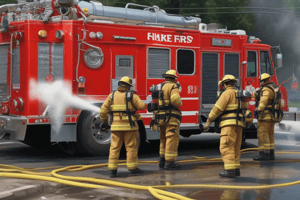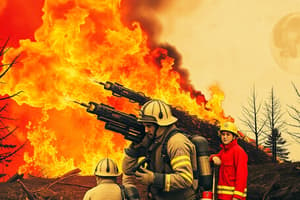Podcast
Questions and Answers
What is a primary reason for a first due engine company to secure a water supply upon arrival at a scene with evidence of a working fire?
What is a primary reason for a first due engine company to secure a water supply upon arrival at a scene with evidence of a working fire?
- To establish a communication line with dispatch
- To guarantee a reliable means of extinguishing the fire (correct)
- To assess the structural integrity of the building
- To ensure adequate manpower for firefighting
Which situation is NOT considered an exception to the guideline of securing a water supply immediately?
Which situation is NOT considered an exception to the guideline of securing a water supply immediately?
- Certain rescue operations requiring full crew
- Unsure of actual fire location in a commercial complex
- Fire in a high-rise building
- Confirmed presence of hazardous materials on-site (correct)
What should be considered crucial when laying supply lines in response to a fire incident?
What should be considered crucial when laying supply lines in response to a fire incident?
- The color of the supply hose used
- The speed at which the hose is laid
- Access problems created by the supply line (correct)
- The temperature of the water being supplied
What tactical method may be employed to improve water supply in challenging environments like remote homes or high fire-load occupancies?
What tactical method may be employed to improve water supply in challenging environments like remote homes or high fire-load occupancies?
Which approach is beneficial when securing supply lines for an effective fire attack?
Which approach is beneficial when securing supply lines for an effective fire attack?
Flashcards are hidden until you start studying
Study Notes
Water Supply for Firefighting
- First due engine companies must secure a water supply when they approach a scene with signs of a working fire.
- Exceptions to securing a water supply include potential rescues needing full crew response, uncertainty of fire location in complex buildings, and fires in high-rise structures.
Special Considerations
- Unique environments such as hillside homes, junkyards, recycling facilities, and high fire-load areas necessitate pre-planning for hose-lays and water sourcing.
- In remote areas with limited hydrants, options include drafting from canals or using extended supply lines.
Tactical Water Supply Management
- Adequate supply lines must reach all tactical positions utilized by fire companies for both interior and exterior attacks.
- The number and configuration of supply lines depend on water supply requirements outlined in the incident action plan.
- Techniques such as "big water" evolutions, tandem pumping, and relay pumping may be employed based on the fire's water supply needs.
Considerations for Laying Supply Lines
- Supply line placement should minimize access issues; ideally, hoses should be laid along the hydrant-side of the road and crossed at the fire scene if needed.
- Slower speeds during hose-laying reduce the risk of accidents involving civilians, vehicles, or firefighters.
- Taking time during hose-laying allows the Company Officer to assess critical factors at the fire scene and lets the Engineer position the apparatus effectively.
Studying That Suits You
Use AI to generate personalized quizzes and flashcards to suit your learning preferences.




